Input interpretation

KOH potassium hydroxide + N_2O_3 nitrogen trioxide ⟶ H_2O water + KNO_2 potassium nitrite
Balanced equation
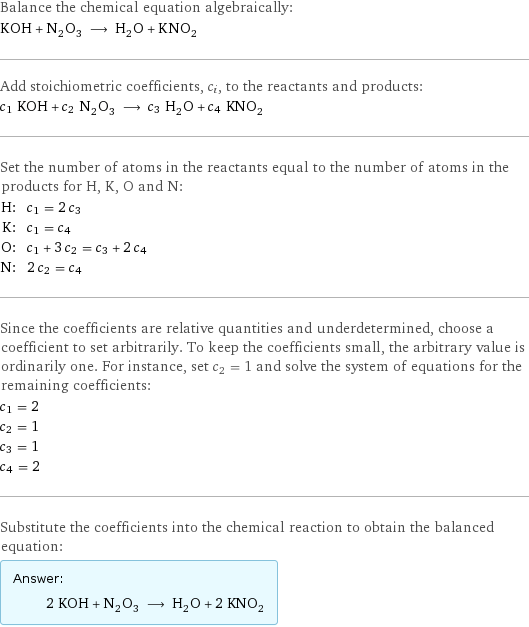
Balance the chemical equation algebraically: KOH + N_2O_3 ⟶ H_2O + KNO_2 Add stoichiometric coefficients, c_i, to the reactants and products: c_1 KOH + c_2 N_2O_3 ⟶ c_3 H_2O + c_4 KNO_2 Set the number of atoms in the reactants equal to the number of atoms in the products for H, K, O and N: H: | c_1 = 2 c_3 K: | c_1 = c_4 O: | c_1 + 3 c_2 = c_3 + 2 c_4 N: | 2 c_2 = c_4 Since the coefficients are relative quantities and underdetermined, choose a coefficient to set arbitrarily. To keep the coefficients small, the arbitrary value is ordinarily one. For instance, set c_2 = 1 and solve the system of equations for the remaining coefficients: c_1 = 2 c_2 = 1 c_3 = 1 c_4 = 2 Substitute the coefficients into the chemical reaction to obtain the balanced equation: Answer: | | 2 KOH + N_2O_3 ⟶ H_2O + 2 KNO_2
Structures

+ ⟶ +
Names

potassium hydroxide + nitrogen trioxide ⟶ water + potassium nitrite
Reaction thermodynamics
Enthalpy
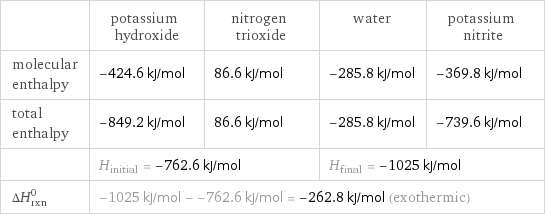
| potassium hydroxide | nitrogen trioxide | water | potassium nitrite molecular enthalpy | -424.6 kJ/mol | 86.6 kJ/mol | -285.8 kJ/mol | -369.8 kJ/mol total enthalpy | -849.2 kJ/mol | 86.6 kJ/mol | -285.8 kJ/mol | -739.6 kJ/mol | H_initial = -762.6 kJ/mol | | H_final = -1025 kJ/mol | ΔH_rxn^0 | -1025 kJ/mol - -762.6 kJ/mol = -262.8 kJ/mol (exothermic) | | |
Gibbs free energy
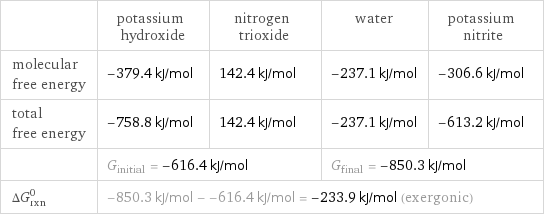
| potassium hydroxide | nitrogen trioxide | water | potassium nitrite molecular free energy | -379.4 kJ/mol | 142.4 kJ/mol | -237.1 kJ/mol | -306.6 kJ/mol total free energy | -758.8 kJ/mol | 142.4 kJ/mol | -237.1 kJ/mol | -613.2 kJ/mol | G_initial = -616.4 kJ/mol | | G_final = -850.3 kJ/mol | ΔG_rxn^0 | -850.3 kJ/mol - -616.4 kJ/mol = -233.9 kJ/mol (exergonic) | | |
Equilibrium constant
![Construct the equilibrium constant, K, expression for: KOH + N_2O_3 ⟶ H_2O + KNO_2 Plan: • Balance the chemical equation. • Determine the stoichiometric numbers. • Assemble the activity expression for each chemical species. • Use the activity expressions to build the equilibrium constant expression. Write the balanced chemical equation: 2 KOH + N_2O_3 ⟶ H_2O + 2 KNO_2 Assign stoichiometric numbers, ν_i, using the stoichiometric coefficients, c_i, from the balanced chemical equation in the following manner: ν_i = -c_i for reactants and ν_i = c_i for products: chemical species | c_i | ν_i KOH | 2 | -2 N_2O_3 | 1 | -1 H_2O | 1 | 1 KNO_2 | 2 | 2 Assemble the activity expressions accounting for the state of matter and ν_i: chemical species | c_i | ν_i | activity expression KOH | 2 | -2 | ([KOH])^(-2) N_2O_3 | 1 | -1 | ([N2O3])^(-1) H_2O | 1 | 1 | [H2O] KNO_2 | 2 | 2 | ([KNO2])^2 The equilibrium constant symbol in the concentration basis is: K_c Mulitply the activity expressions to arrive at the K_c expression: Answer: | | K_c = ([KOH])^(-2) ([N2O3])^(-1) [H2O] ([KNO2])^2 = ([H2O] ([KNO2])^2)/(([KOH])^2 [N2O3])](../image_source/d82b3de904ac246fa626cf82d59790d7.png)
Construct the equilibrium constant, K, expression for: KOH + N_2O_3 ⟶ H_2O + KNO_2 Plan: • Balance the chemical equation. • Determine the stoichiometric numbers. • Assemble the activity expression for each chemical species. • Use the activity expressions to build the equilibrium constant expression. Write the balanced chemical equation: 2 KOH + N_2O_3 ⟶ H_2O + 2 KNO_2 Assign stoichiometric numbers, ν_i, using the stoichiometric coefficients, c_i, from the balanced chemical equation in the following manner: ν_i = -c_i for reactants and ν_i = c_i for products: chemical species | c_i | ν_i KOH | 2 | -2 N_2O_3 | 1 | -1 H_2O | 1 | 1 KNO_2 | 2 | 2 Assemble the activity expressions accounting for the state of matter and ν_i: chemical species | c_i | ν_i | activity expression KOH | 2 | -2 | ([KOH])^(-2) N_2O_3 | 1 | -1 | ([N2O3])^(-1) H_2O | 1 | 1 | [H2O] KNO_2 | 2 | 2 | ([KNO2])^2 The equilibrium constant symbol in the concentration basis is: K_c Mulitply the activity expressions to arrive at the K_c expression: Answer: | | K_c = ([KOH])^(-2) ([N2O3])^(-1) [H2O] ([KNO2])^2 = ([H2O] ([KNO2])^2)/(([KOH])^2 [N2O3])
Rate of reaction
![Construct the rate of reaction expression for: KOH + N_2O_3 ⟶ H_2O + KNO_2 Plan: • Balance the chemical equation. • Determine the stoichiometric numbers. • Assemble the rate term for each chemical species. • Write the rate of reaction expression. Write the balanced chemical equation: 2 KOH + N_2O_3 ⟶ H_2O + 2 KNO_2 Assign stoichiometric numbers, ν_i, using the stoichiometric coefficients, c_i, from the balanced chemical equation in the following manner: ν_i = -c_i for reactants and ν_i = c_i for products: chemical species | c_i | ν_i KOH | 2 | -2 N_2O_3 | 1 | -1 H_2O | 1 | 1 KNO_2 | 2 | 2 The rate term for each chemical species, B_i, is 1/ν_i(Δ[B_i])/(Δt) where [B_i] is the amount concentration and t is time: chemical species | c_i | ν_i | rate term KOH | 2 | -2 | -1/2 (Δ[KOH])/(Δt) N_2O_3 | 1 | -1 | -(Δ[N2O3])/(Δt) H_2O | 1 | 1 | (Δ[H2O])/(Δt) KNO_2 | 2 | 2 | 1/2 (Δ[KNO2])/(Δt) (for infinitesimal rate of change, replace Δ with d) Set the rate terms equal to each other to arrive at the rate expression: Answer: | | rate = -1/2 (Δ[KOH])/(Δt) = -(Δ[N2O3])/(Δt) = (Δ[H2O])/(Δt) = 1/2 (Δ[KNO2])/(Δt) (assuming constant volume and no accumulation of intermediates or side products)](../image_source/e0359bf24014acecee64914f518e908e.png)
Construct the rate of reaction expression for: KOH + N_2O_3 ⟶ H_2O + KNO_2 Plan: • Balance the chemical equation. • Determine the stoichiometric numbers. • Assemble the rate term for each chemical species. • Write the rate of reaction expression. Write the balanced chemical equation: 2 KOH + N_2O_3 ⟶ H_2O + 2 KNO_2 Assign stoichiometric numbers, ν_i, using the stoichiometric coefficients, c_i, from the balanced chemical equation in the following manner: ν_i = -c_i for reactants and ν_i = c_i for products: chemical species | c_i | ν_i KOH | 2 | -2 N_2O_3 | 1 | -1 H_2O | 1 | 1 KNO_2 | 2 | 2 The rate term for each chemical species, B_i, is 1/ν_i(Δ[B_i])/(Δt) where [B_i] is the amount concentration and t is time: chemical species | c_i | ν_i | rate term KOH | 2 | -2 | -1/2 (Δ[KOH])/(Δt) N_2O_3 | 1 | -1 | -(Δ[N2O3])/(Δt) H_2O | 1 | 1 | (Δ[H2O])/(Δt) KNO_2 | 2 | 2 | 1/2 (Δ[KNO2])/(Δt) (for infinitesimal rate of change, replace Δ with d) Set the rate terms equal to each other to arrive at the rate expression: Answer: | | rate = -1/2 (Δ[KOH])/(Δt) = -(Δ[N2O3])/(Δt) = (Δ[H2O])/(Δt) = 1/2 (Δ[KNO2])/(Δt) (assuming constant volume and no accumulation of intermediates or side products)
Chemical names and formulas
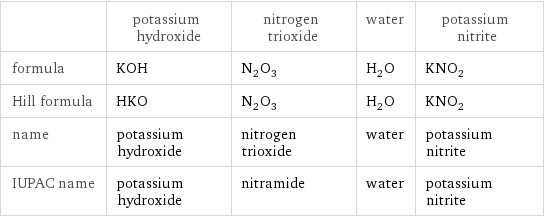
| potassium hydroxide | nitrogen trioxide | water | potassium nitrite formula | KOH | N_2O_3 | H_2O | KNO_2 Hill formula | HKO | N_2O_3 | H_2O | KNO_2 name | potassium hydroxide | nitrogen trioxide | water | potassium nitrite IUPAC name | potassium hydroxide | nitramide | water | potassium nitrite
Substance properties
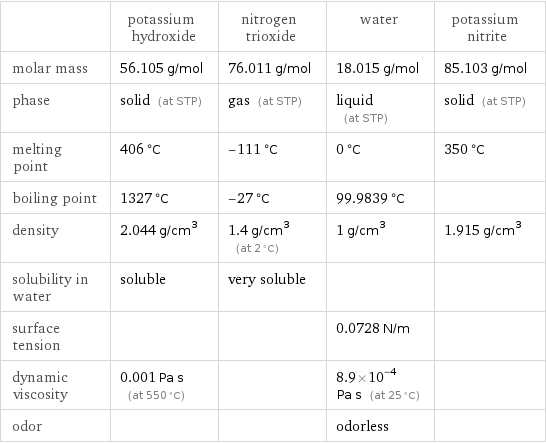
| potassium hydroxide | nitrogen trioxide | water | potassium nitrite molar mass | 56.105 g/mol | 76.011 g/mol | 18.015 g/mol | 85.103 g/mol phase | solid (at STP) | gas (at STP) | liquid (at STP) | solid (at STP) melting point | 406 °C | -111 °C | 0 °C | 350 °C boiling point | 1327 °C | -27 °C | 99.9839 °C | density | 2.044 g/cm^3 | 1.4 g/cm^3 (at 2 °C) | 1 g/cm^3 | 1.915 g/cm^3 solubility in water | soluble | very soluble | | surface tension | | | 0.0728 N/m | dynamic viscosity | 0.001 Pa s (at 550 °C) | | 8.9×10^-4 Pa s (at 25 °C) | odor | | | odorless |
Units
